
|
A RUSH TO JUDGEMENT: Chapter 3 |

|
|---|
THE FIRST CRACKS BEGIN TO APPEAR
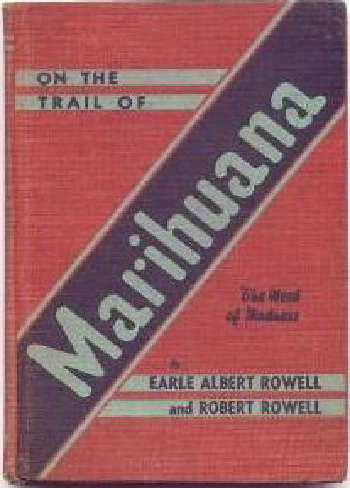
|
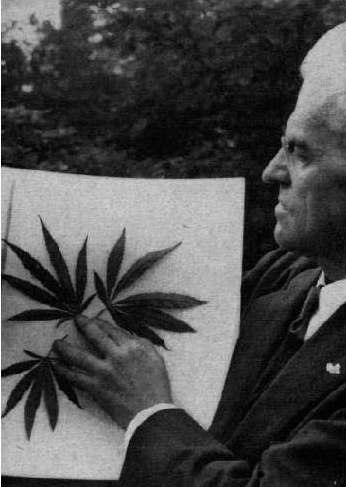
|
3.1 - The D.E.A.’s (aka the Federal Bureau of Narcotics) VERSION:
The DEA’s version of the story (while varying a bit over time), generally runs as follows:
-
. . . A normally sane and quiet young boy . . .
. . . somehow obtained and smoked some Reefers (Marihuana cigarettes) . . . .
. . . that night, he started hallucinating . . .
. . . he imagined that his parents were attacking and cutting him up . . .
. . . thus he grabbed an axe and killed his parents, two brothers and a sister in their sleep . . .
. . . the next day, he could remember nothing of what happened . . . etc.
Looking back on it, it now seems incredible that the story could have held out for as long as it did (from the 1930’s up until the late 1960's) without being seriously challenged. Anyone doing even the most rudimentary research on the matter could have quickly noted the contradictions as well as the out and out falsehoods. However, it should be pointed out that back in the 1930’s the American people had an almost blind faith in their government. That whatever else, our very own Federal Government would never lie to the American people.
This blind faith in government seems to have lasted right on up until the Vietnam War, when it became obvious to just about everyone that this (if it ever was), was no longer the case.
In addition (and here we are not defending Anslinger, but simply pointing out the facts), that until the early part of 1936, the Bureau relied mostly on newspaper reports as their main source of information. It was only AFTER 1936 (when the first challenges to the Gore File came), that the Bureau started ACTUALLY checking up on its facts. Small wonder then that most of the more bestial Gore File cases (as well as many of the fabricated cases) made their way into the file before 1936 and relatively few thereafter.
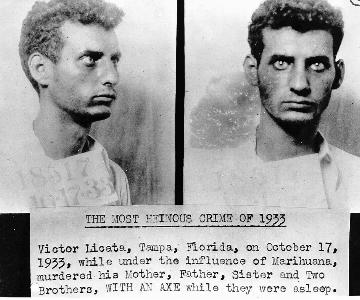
The most famous Mug Shot from the Reefer Madness Era
QUESTION: How did this Mug Shot come to be so widely viewed?
ANSWER: While Anslinger had been touting the Victor Licata case (as part of his gore file) for some time previously, it was not until January of 1937 that he received the following letter:
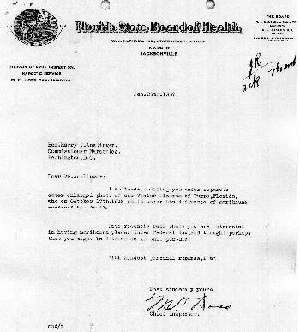
Click on Picture for Bigger View
Harry Anslinger kept the picture in his files as part of his gore file. And upon retirement he then donated it (along with large numbers of his personal papers) to Penn State University. There it was located by researchers, photocopied and made widely available.
Florida State Board of health
DIVISION OF DRUG INSPECTION
Narcotic service
M.H. DOSE, chief inspector
Jan. 29th, 1937
Hon. Harry J. Anslinger.
Commissioner narcotics.
Washington, D.C.
Dear Mr. Anslinger;
I am today mailing you under separate cover enlarged photo of one Victor Licarta (sic) of Tampa, Florida, who on October 17th 1933 under the influence of marihuana murdered his family.
Have recently read where you are interested in having marihuana placed under federal law, and thought perhaps that you might be interested in this picture.
With kindest personal regards, I am
Most sincerely yours,
(signed) M.H. Doss
Chief Inspector
Which is a good thing as it contained his Arrest ID number, which in turn allowed us to locate much of the paperwork that we have on him.
3.2 - EARLE ROWELL TELLS A DIFFERENT VERSION OF THE STORY:
The following is taken directly from Mr. Rowell’s Book [1939], “On the trail of Marihuana, the Weed of Madness.”
“VICTOR LICATA, aged nineteen, sat sobbing. He was in jail in Tampa, Florida, his home town; and, although he had been there half a day, his parents had not been near him. He wondered why they had forgotten or were neglecting him. This was why he was crying.
He didn't know that his mother and father were dead; that his two brothers and his sister were also dead; in fact, that his whole family, except a brother away at the university, had been killed. He knew they were alive the day before; he had been with them then.
No, he didn't know they were dead. And, what is more, he didn't know he was the one who had killed them! He didn't remember that in the middle of the night he had arisen, taken an axe, and hacked his mother, father, two brothers, and sister to pieces while they slept.
He didn't know any of this; but the police did - all of it. What the police did not know was why he had killed his family. As they questioned him, he was bewildered, confused, and even surprised that his folks were dead, and astounded when told that he had killed them.
After the police had told the boy why he was in jail, he told them what he could remember of what happened prior to his killing five members of his family. It was an incoherent story. He had spent most of the night, so he said, trying to prevent someone from cutting off his arms and legs.
Under patient questioning the story was eventually pieced together. Victor had smoked some marihuana cigarettes that afternoon. After going to bed that night, he suddenly thought, as nightmarish hallucinations raced through his mind, that his mother and father were plotting to cut off his arms and legs as soon as they got up in the morning. This horrible obsession fixed itself in his mind; and so real was this imagined threat to him that he decided the only thing to do was to kill them first, while they slept.
On our tour of the states, we arrived in Tampa a few months after this horrible crime took place. The police and district attorneys' staff who worked on the case told us the entire terrible and fantastic story, and took us to the house where the crime had been enacted.
The police confided to us also that the father, who had been murdered, was by no means blameless, for he had been making these cigarettes and having his son Victor peddle them to the students at the high school he attended. In time, Victor sampled his own product. Then came the quintuple murder. Thus the father, who had sown the wind, reaped the whirlwind.
This crime struck home to the hearts and minds of the inhabitants of Florida the terrific potency of marihuana. Many months later we found the memory of this atrocity to be very vivid; the whole state had become marihuana-conscious.
A law with real teeth in it to prohibit peddlers was rushed through the state legislature. The Parent-Teacher Associations were so aroused and so intent that the youth of Florida should know the facts concerning marihuana that we were kept there for more than eight months, speaking to high schools, youth groups, parent groups, et cetera, all part of an effective educational campaign.”
To our knowledge this is the first variation of the official story as offered by Anslinger’s D.E.A. (aka Bureau of Narcotics). Now instead of an innocent family we have:
“. . [the] police confided to us also that the father, who had been murdered, was by no means blameless, for he had been making these cigarettes and having his son Victor peddle them to the students at the high school he attended.”Thus a version of the story that varied slightly from the official version now made its appearance. And while this slight variation seems almost insignificant to us today, to Harry Anslinger, this was a great affront, one that would seal Mr. Rowell’s fate. Anslinger was not about to have his favorite Gore File case discredited by anyone for any reason.
3.3 - HARRY ANLSINGER’S D.E.A. GOES AFTER EARLE ROWELL:
Many of Harry Anslinger's apologists would argue that he was “Just doing his Job.” That the country was in the Great Depression, and that it simply needed a strong hand to keep things going. Maybe so, but by all accounts, Anslinger was not a nice man. As stated previously, he was out and out Evil. The Earle Rowell situation provides a specific case in point. Now granted there were a lot of reasons why Anslinger hated Rowell. Probably the most important of which was that Rowell (who had quite a following in the 1930’s) felt that drug addicts should be given maintenance drugs, while Anslinger felt the solution was to lock them up and that was it.
However, be that as it may, it is obvious that Rowell’s challenge of the Bureaus official version of the Victor Licata story was also high on that list. According to Alfred Lindesmith (who was also one of Anslinger's targeted victims): [3A]
“Mr. Rowell came into disfavor with the Bureau's of Narcotics around 1938 and this agency spent considerable energy and manpower in an attempt silence and discredit him . . . This may have been because of Mr. Rowell's view that opiate addiction is a disease, or perhaps because of his repeated allegations that the police were insufficiently diligent in destroying marihuana. . . “Elsewhere, he elaborated more on the subject. In his book “The Addict and the Law (1961)”, Lindesmith writes: [3B]
[Regarding his communications with Everett G. Hoffman, head of the World Narcotics Research Foundation of Seattle Wa., who shared Mr. Lindesmith's views on drugs,and who like Rowell and Lindesmith was also targeted by Anslinger's Bureau of Narcotics for arrest]Once more Mr. Anslinger was not a nice man. And he was NOT ABOUT to have anyone challenge his Victor Licata story under any circumstances.
“And although Mr. Hoffman himself was not arrested, . . . . “Through him I learned that the Narcotics Bureau was somewhat more successful in silencing Earl Albert Rowell and his son, who were going about the country in the 1930's giving lectures on the marihuana problem. Mr. Earl Rowell claimed to have made speeches in 40 of the states. His disagreement with the Federal Narcotics Bureau seemed to arise from his disposition to criticize the police for inactivity and complacency and from his contention that official handouts were covering up and minimizing a growing drug problem. . . .
According to Mr. Rowell's reports to Mr. Hoffman, which were forwarded to me, the Federal Bureau and its agents utilized the following tactics against Mr. Rowell: In January 1938 [3D] he was arrested in Wayne, Pennsylvania, and threatened with prosecution on the grounds that the opium pipe and small quantities of narcotics which he used as exhibits constituted illegal possession of narcotics although they had been supplied to him by police officers for that purpose. Although there was no follow up to this charge, the Bureau broadcast far and wide that Rowell had been arrested; he was accused of obtaining money under false pretenses, of making a racket of his anti-narcotics campaign, and of advocating programs contrary to the policies of the federal government. In Evanston, Illinois, he was threatened with prosecution for failure to pay an Amusement Tax, allegedly at the instigation of federal officials who were determined to curb his activities; he was followed and watched on his lecture tour by narcotics agents. Derogatory information concerning Mr. Rowell was sent by wire and by mail to influential persons in the communities where speeches had been scheduled, causing some of them to be cancelled; when cancellations occurred and when local citizens made investigations of Rowell after hearing from Washington. Such cancellations and investigations were written up and circulated by narcotics officials to discredit Rowell in other communities.
The version of Mr. Rowell's dealings with federal narcotics agents, which is given in the preceding paragraph, is Mr. Rowell's and is no doubt one-sided and slanted in his own favor. We have seen in our discussion of marihuana that Mr. Rowell was strongly opposed to the use of this "weed of madness," which he thought was a direct cause of insanity and violence, and that he was only slightly less alarmed about alcohol and tobacco. This point of view alone could hardly have brought him into conflict with Treasury Department officials. The real point in this imbroglio is not the correctness of his views or even whether his crusade was a racket or not, but whether it is the function of the federal anti-narcotics police force to curb reformers as well as the use of drugs.”
3.4 – MUSEUM CONCLUSIONS:
In all fairness to the reader, it should be pointed out that Earle Rowell was at one time the head of Northern California’s “White Cross Anti-Narcotics League”, whose views on narcotics addition are shared by many others and are as follows:
- If you’re a drug addict, you will be allowed to have legal maintenance drugs
- If you’re a drug dealer, you will be taken out and shot
HOWEVER, in terms of Earle Rowell’s, conclusions regarding the Victor Licata affair, this author is of the belief that Mr. Rowell's logical mind might have been clouded by his emotions at the time. Perhaps an explanation is in order, and while not wishing to jump the gun on succeeding chapters, it is important to note that there might (most probably was) a serial axe murderer operating in the Tampa Florida area at the time. AND that one of the families that (just like the Licata family) had been struck was the ROWELL family. Thus, it might not have been an accident that:
“On our tour of the states we arrived in Tampa a few months after this horrible crime took place.”And while we have no proof that Earle Rowell was very closely related to the three Rowell family members (plus others) who were killed by an axe murderer in (1926) Tampa Fla., still we find it odd that:
“The police and district attorneys' staff who worked on the case told us the entire terrible and fantastic story, and took us to the house where the crime had been enacted. The police confided to us also that the father, who had been murdered, was by no means blameless, for he had been making these cigarettes and having his son Victor peddle them to the students at the high school he attended. In time, Victor sampled his own product. Then came the quintuple murder.”QUESTION: Why would the police, the district attorney's office, etc., give Mr. Rowell (who was not even a Florida resident) a guided tour of a crime seen? Then confide in him and give him so much (probably false) information about Victor? EXAMPLE:
“The police confided to us also that the father, . . had been making these cigarettes and having his son Victor peddle them to the students at the high school he attended.”PROBLEM: Victor was either 19 or 20 years of age at the time. In addition, the police were falsely claiming that he was 21 years of age at the time. [3C] Which would have made it all but impossible for him to have been a high school student.
However, the guided tour could be explained away as an effort to get a new law against the use of Medical Marihuana in place. As Mr. Rowell stated in his book:
“This crime struck home in the hearts and minds of the inhabitants of Florida the terrific potency of marihuana. Many months later we found the memory of this atrocity to be very vivid; the whole state had become marihuana-conscious. A law with real teeth in it to prohibit peddlers was rushed through the state legislature."“CONCLUSIONS:
- Earle Rowell’s story varied only slightly from that one being given by Harry Anslinger and the DEA at the time. However, it was enough to get Rowell on Anslinger’s radar set, thus leading to his downfall.
- That Mr. Rowell did NOT actually investigate the Victor Licata Incident, but relied solely on what police officials (who obviously had an agenda of their own) had told him about it.
- Mr. Rowell's book is the first which brings out the fact that there was some kind of Mafia or crime connection to the story.
- Mr. Rowell may have had an emotional involvement in the case, ---- something that would have clouded his judgment.
- He simply accepted what the local police had said about the case, without any form of personal investigation.
- He did not interview Victor Licata, nor did he read any of the local newspaper accounts of the story – which (being present in Tampa) he could have done by simply going to a local public library, etc.
- He (although probably aware of it), made no mention of Moonshine liquor.
ALL FACTORS that (despite bringing out the criminal connection), would lead to the Legend of Victor being perpetrated by the narcs for as long as it did.
===========
FOOTNOTES:
[3A] - The Marijuana Papers – Chapter 2, The Marihuana Problem: Myth or Reality? by Alfred Lindesmith
[3B] - The Addict and the Law By Alfred R. Lindesmith, Washington Post, 1961, Chapter 9, OBSTACLES TO REFORM - Copy can be found at:
http://www.onlinepot.org/addictandthelaw/AddictandtheLaw/chapter09.htm
[3D] - Note the date (Jan 1938), meaning that the harassment of Rowell had already began before he had even published his book, On the Trail of Marihuana" (1939).
[3C]- More about this subject in a later chapter
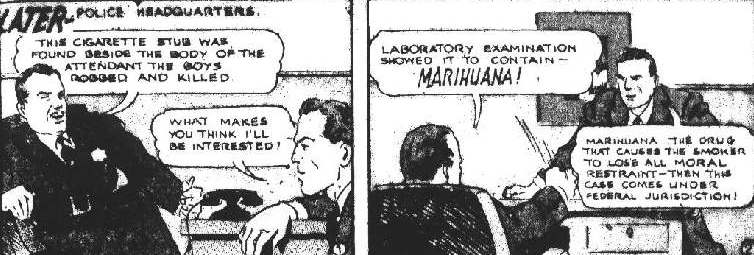
Reefer Madness - courtesy of Harry J. Anslinger
VICTOR LICATA - A RUSH TO JUDGEMENT
WANT TO KNOW MORE:
=====================
Due to space / download time considerations, only selected materials are displayed. If you would like to obtain more information, feel free to contact the museum. All our material is available (at cost) on CD-Rom format. Please contact: antique_andy@catholic.org
 Back to Chapter 2 |
 VICTOR LICATA MAIN INDEX |
 On to Chapter 4 |